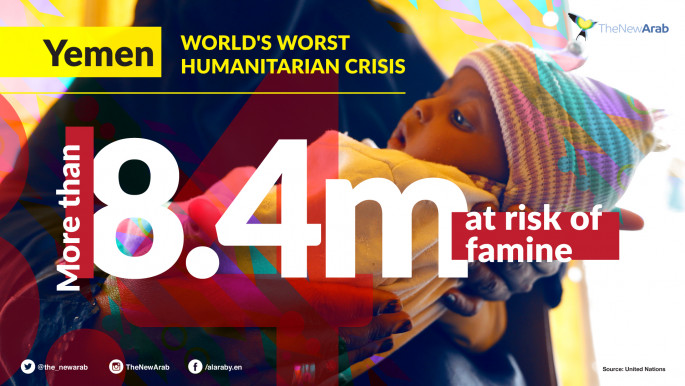
It's time to get real about the death toll in Yemen
Except we've been hearing that statistic for close to a year now, one that was conservative to begin with. Now, after 1,000 days in conflict have passed, it's time to get real about the true impact of the war as it goes far beyond 10,000 and here's why.
Getting accurate information from Yemen's war zone is undoubtedly difficult. In fact, statistics often come from those health centres that count their dead, but there are many other hospitals and facilities that don't.
Casualties include combatants and civilians - victims of direct aggression, though many others have fallen foul of the conflict and the actions of the Saudi-led coalition and Houthi forces, even if they weren't directly caught up in the fighting or branded as collateral damage.
Many have perished due to starvation, or a lack of access to healthcare and medical aid.
In November 2017, Save the Children reported that 130 children were dying every day, with 50,000 children already believed to have died in 2017.
In December 2016, UNICEF reported that a child dies every 10 minutes from preventable diseases such as diarrhoea, malnutrition and respiratory tract infections. And the UK-based NGO, Disasters and Emergencies Committee's recent report put the number of deaths from preventable causes at 10,000.
Read more: Missiles may be the weapon of the weak, but they expose political weaknesses
As a cholera outbreak swept Yemen this year, the last count in July 2017 found 2,177 deaths associated with it.
Many more, however, are currently staring death in the face. Suspected cases reached 862,858 (as of that last count) and 5,000 new cases were being detected daily.
Famine is threatening to take hold of the country, throwing millions more into food insecurity. The UN security chief has said millions will die, and this will be a direct man-made result of the war.
Under siege
In response to attacks by the Saudi Arabia-led coalition, which backs President Abdrabbuh Mansour Hadi, Houthi forces fired a missile towards the airport of Riyadh.
Saudi Arabia announced a new blockade on all Yemen's air, sea and land ports, locking in 27 million people and locking out 500,000 metric tonnes (MT) of food and fuel, and 1,476 MT of aid. Saudi Arabia reopened some ports, but the main ports Hodeidah and Saleef, which serve two-thirds of the population, have remain closed, only opening for limited humanitarian assistance.
Bowing to international pressure, Saudi Arabia recently announced that Hodeida port will now open for at least 30 days.
 |
|
But to date, the blockade has put a huge strain on the availability of food in markets, and the rise of fuel prices makes it more difficult to deliver humanitarian assistance. As well as supply, demand is compromised through unpaid salaries, a cash crisis and the increase in basic food prices from import delays through the ports and road taxes.
In addition, crucial civilian infrastructure has been destroyed, including health centres, markets, and water and sanitation infrastructure, increasing vulnerability to disease.
According to the Yemen Data Project - an independent initiative to collect and disseminate data on the war in Yemen - out of 15,489 attacks, around one-third are known to have hit non-military targets (4,509). There are still 4,803 attacks for which the target is unknown.
But for those that have been identified, only 5,883 (around one-third of all attacks) were directed at military or security targets, and 294 were targeted at political or tribal figures.
Of the remainder:
- 1,422 hit residential areas.
- 625 hit transport infrastructure.
- 386 hit farms.
- 342 hit educational facilities.
- 256 hit government compounds.
- 225 hit civilian vehicles.
- 215 hit private businesses.
- 183 hit market places.
- 164 hit communications infrastructure.
- 112 hit oil and gas structures.
- 103 hit water and electricity structures.
- 71 hit factories.
- 69 hit cultural/heritage sites.
- 68 hit medical facilities.
- 62 hit food storage/transportation.
- 58 hit sports facilities.
- 44 hit mosques.
- 36 hit parks/resorts.
- 18 hit media targets.
- 13 hit premises of the international community.
- 13 hit social gatherings.
- 11 hit banks.
- 9 hit other state resources.
- 4 hit IDP camps.
As well as the obvious gross crime of hitting civilians, these attacks have damaged or destroyed infrastructure that is key to the survival of Yemeni civilians.
This data focuses on the aerial bombardments in Yemen from March 2015 to August 2016, including data on all air raids conducted by the Saudi Arabia led coalition. Of the 30,405 known air raids, 7,464 definitely took place against 4,509 non-military targets. But of the 15k plus attacks, in 1,474 cases we do not know whether there were air raids or not.
For every damning number we do know, there is an invisible number that is incredibly difficult to find.
 |
For every damning number we do know, there is an invisible number that is incredibly difficult to find |  |
The effect on civilians however, is indisputable. International humanitarian law dictates that only military objects can be targeted in war. There needs to be a full-scale UN commission of inquiry into human rights abuses by all sides in this conflict.
Indeed, there is much more to the death toll than we hear of, and repeating '10,000' over and over again does nothing but dilute the true scale of devastation to the country.
Sophia Akram is a researcher and communications professional with a special interest in human rights particularly across the Middle East.
Follow her on Twitter: @mssophiaakram
Opinions expressed in this article remain those of the author and do not necessarily represent those of The New Arab, its editorial board or staff.




